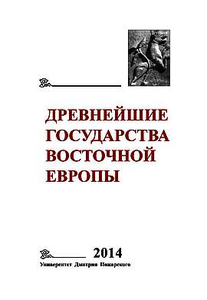The Earliest States of Eastern Europe. 2014: Old Rus’ and Medieval Europe: The Origin of States / Editor of the volume T.N. Jackson. Moscow: Dmitriy Pozharsky University, 2016

The almanac "The Earliest States of Eastern Europe" for 2014 is devoted to the problem of the emergence and formation of early medieval states. It mainly includes reports read at the international conference "Old Rus' and Medieval Europe: the emergence of states" (Institute of General History of the Russian Academy of Sciences, 2012). The main objectives of this volume are to present the general theoretical state of modern studies of early states and highlight the history of specific state formations in Europe, including Old Rus'. The volume discusses the role of migration in the processes of the emergence of the state, large-scale construction, the transformation of the status of the ruler, the formation of state institutions. Reviews of the ways of formation of states in Bulgaria, Pomorie, Russia are presented. The role of international relations in the formation of the Old Russian state is emphasized. A separate block of articles is devoted to medieval Kherson in the context of the history of Byzantium and the Black Sea region. Written from different theoretical positions, published articles demonstrate the variety of processes that caused the emergence of different medieval states, and various forms of their socio-political organization.
Table of contents
- E. A. Melnikova - Introduction - 5-7
- H. Claessen - The Early State: A Structural Approach (translated by N.N. Kradin, edited by E.A. Melnikova) - 8-90
- N. N. Kradin - Political anthropology on state origins - 91-115
- H. Härke - Migrations and state formation in the early middle ages: A view from the west - 116-130
- M. Carver - Mound-building and state-building: A poetic discourse - 131-157
- G. Astill - Revisiting the English state, AD c. 700–1100 - 158-178
- D. Skre - Norðvegr – Norway: From Sea Kings to Land Kings - 179-192
- T. Stepanov - Bulgar Polities in the 4th – 9th Centuries: From Chiefdom to the Early State - 193-212
- P. Tolochko - The origins of East-Slavic polity - 213-230
- M. Mägi - The origin of Rus’ and the question of Balto-Finnic role in this process - 231-257
- T. Pushkina, N. Eniosova - Gnezdovo as the early urban center in the age of formation of the early Russian state: Some problems of its interpretation - 258-303
- A. A. Gorsky - Discussing the formation of the posadnik system in Rus’ - 304-317
- B. Florya - Stages of formation of the state in Western Pomerania - 318-324
- J. Shepard - History as propaganda, proto-foundation myth and “tract for the times” in the long eleventh century (c. 1000 – c. 1130) - 332-355
- I. Wood - Western Missionaries in Eastern Europe, 962–1009 - 356-378
- A. Poppe - Gab es eine Ottonische Ostpolitik, die die Kiewer Rus’ im Blickfeld hatte? - 379-400
- A. Musin - Matrimonial alliance of Henry I, King of France, and Anne, daughter of Yaroslav the Wise, Prince of Kiev: reasons, background, consequences - 401-434
- N. Alekseenko - Imperial administration of Cherson: from archontia to katepanate (the evidence of seals) - 435-474
- V. Naumenko - From the Thema of Klimata to the Thema of Cherson: characteristics of Byzantine military and administrative model in Taurica in the mid-ninth – early tenth centuries - 475-506
- L. V. Stolyarova - The new edition of the earliest Smolensk diplomas of the thirteenth and fourteenth centuries (on the publication by A. Ivanov and A. Kuznetsov) - 507-534
